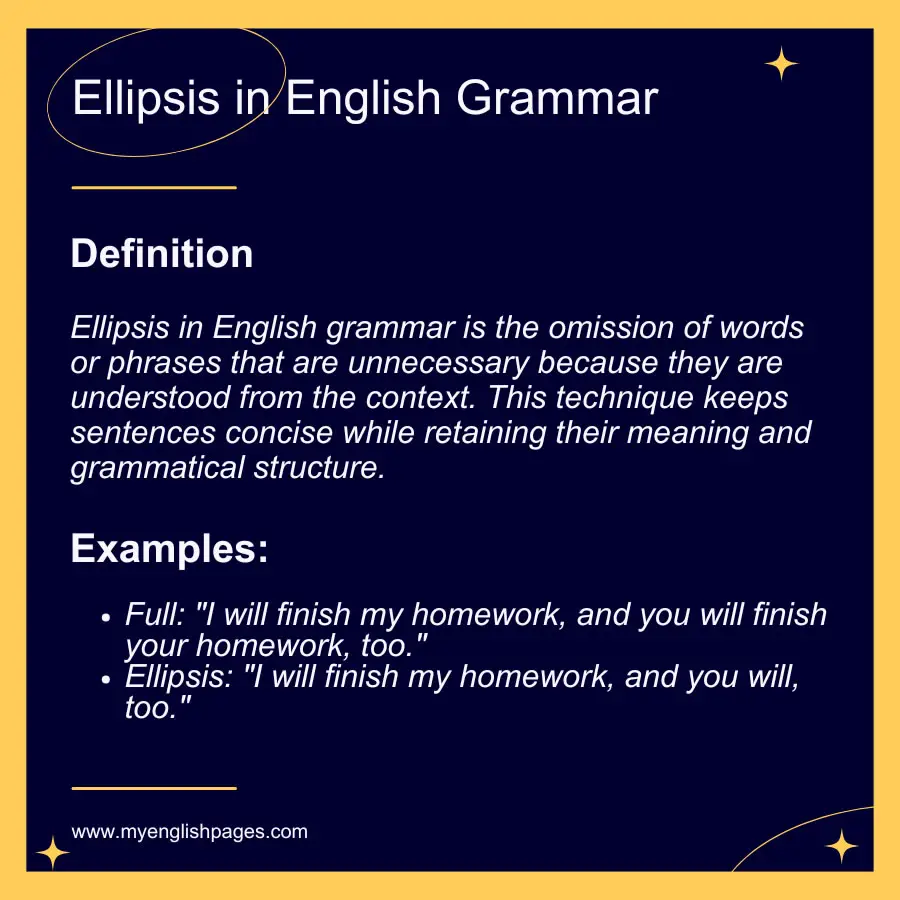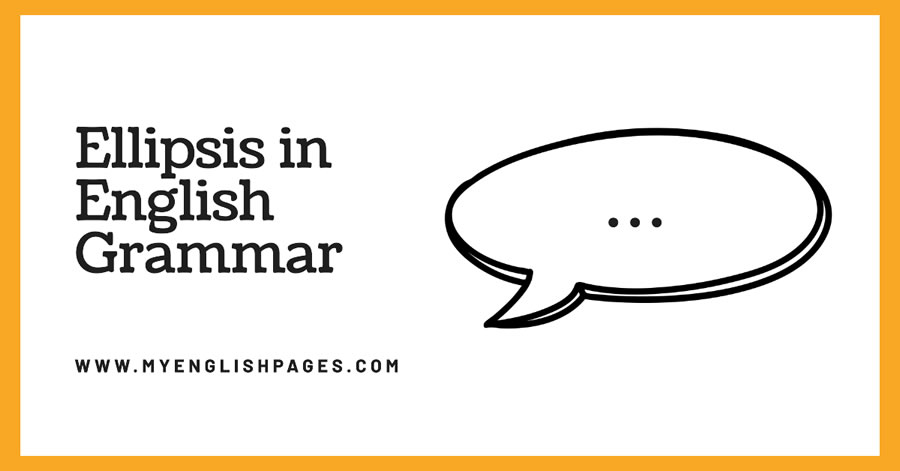Table of Contents
Introduction
In English grammar, ellipsis refers to the deliberate omission of words or phrases from a sentence without compromising its grammatical structure or meaning.
This post explores the concept of ellipsis, its type, and how to use it in English!
What is Ellipsis in English Grammar?
Ellipsis in English grammar is the omission of words or phrases that are unnecessary because they are understood from the context. This technique keeps sentences concise while retaining their meaning and grammatical structure.
For example:
- Full sentences:
- “She loves chocolate, and he loves chocolate, too.”
- “I was going to the park, and she was going to the park, too.”
- Ellipsis:
- “She loves chocolate, and he does, too.”
- “I was going to the park, and she was, too.”
Removing the repeated phrases “going to the park” and “loves chocolate” makes the sentence shorter and more natural without losing meaning.
Ellipsis is widely used in both spoken and written English to avoid repetition, streamline communication, and enhance fluency.
To learn more about elliptical constructions in writing, explore our comprehensive guide.
When is Ellipsis Used?
Ellipsis in English is used in both everyday speech and writing, allowing you to streamline sentences by omitting words that can be easily inferred from the context.
When used correctly, ellipsis enhances fluency and clarity, making your English sound more natural and professional, whether in conversation or formal writing.
In the following sections, we’ll explore the different types of ellipsis, when to use them, and provide practical tips to avoid common mistakes.

Types of Ellipsis in English
Ellipsis can be categorized into several types based on the context and grammatical elements omitted. Here are the most common types:
1. Verb Phrase Ellipsis
This involves omitting parts of a verb phrase when they are understood from the context.
- Example:
- Full: “I have been working hard, and you have been working hard, too.”
- Ellipsis: “I have been working hard, and you have, too.”
It is often used with auxiliary verbs like have, do, or be.
2. Gapping
Gapping occurs when repeated words in a coordinated structure are omitted.
- Example:
- Full: “She plays the piano, and he plays the guitar.”
- Gapped: “She plays the piano, and he, the guitar.”
3. Nominal Ellipsis
This type omits the noun when the meaning is clear from the context.
- Example:
- Full: “The red dress is beautiful, but the blue dress is even more so.”
- Ellipsis: “The red dress is beautiful, but the blue, even more so.”
4. Comparative Ellipsis
Words are omitted in comparative structures to avoid repetition.
- Example:
- Full: “She is more experienced than he is experienced.”
- Ellipsis: “She is more experienced than he is.”
5. Ellipsis in Questions
Ellipsis simplifies questions by dropping unnecessary parts.
- Example:
- Full: “Who is coming to the meeting?”
- Ellipsis: “Who?”
6. Ellipsis in Answers
Answer ellipsis occurs in question-answer exchanges, where the response omits redundant information already present in the question. The question typically contains an interrogative word (e.g., who, what, when), and the answer focuses on providing the missing information while leaving out the rest.
- Examples:
- Q: Who did the job?
A: Nancy did. - Q: What have you been doing?
A: Working.
- Q: Who did the job?
7. Sluicing
Sluicing is a form of ellipsis where everything in a direct or indirect question is omitted except for the question word.
- Full: Jane is planning something, but I don’t know what she is planning.
With Sluicing: Jane is planning something, but I don’t know what. - Full: I don’t know what she will do, but Jane will definitely do something.
With Sluicing: I don’t know what, but jane will definitely do something.
Rules for Using Ellipsis
To use ellipsis effectively, it’s important to follow these key rules:
1. Clarity is Key
Ensure the omitted parts are easily understood from the context. The meaning of the sentence should remain clear even after the omission.
2. Avoid Ambiguity
Ellipsis should not create confusion or multiple interpretations.
- Example of ambiguity:
- Ambiguous: “He likes chocolate more than her.”
(Does he like chocolate more than she does, or more than he likes her?) - Clear: “He likes chocolate more than she does.”
- Ambiguous: “He likes chocolate more than her.”
3. Stay Grammatically Correct
The sentence must remain structurally sound after omitting words. The grammatical integrity of the sentence should not be compromised.
Common Mistakes in Using Ellipsis
While ellipsis is a powerful tool for conciseness, improper use can lead to confusion or poor sentence flow. Here are common mistakes to avoid:
1. Overusing Ellipsis
Excessive omissions can make sentences overly complex and hard to follow.
- Example:
- “She can play the piano; he, the guitar; and they, the violin.”
- Tip: Use ellipsis sparingly to maintain clarity and readability.
2. Misleading Context
Ellipsis can cause confusion if the context is unclear or ambiguous.
- Example:
- “He didn’t go to the party, but she did.”
(Does this mean she went to the party, or she didn’t go either?) - Tip: Ensure the omitted part is unambiguous and readily understood from the context.
- “He didn’t go to the party, but she did.”
Examples of Ellipsis in Sentences
Here are five examples showcasing how ellipsis can be used effectively:
- “I will finish my homework, and you will (finish your homework), too.” (Verb Phrase)
- “She plays the piano, and he (plays) the guitar.” (Gapping)
- “John did five pushups and Mary did four (pushups).” (Nominal)
- “The big dog ran faster than we expected (it would run). (Comparative)
- Q: “Are you coming to the meeting?”
A. Ellipsis: “Coming?”- (Questions)
- Q: Who has been lying?
A: Jane (has been lying)!- (Answers)
- He will reply to the offer, but I don’t know when (he will reply).
Practice Exercise: Identify the Omitted Part
In the following sentences, parts of the text have been omitted using ellipsis. Your task is to identify the omitted words or phrases.
- Sentence: “She loves reading novels, and he, poetry.”
- Omitted part: ______
- Sentence: “I’ve been working hard, and they have, too.”
- Omitted part: ______
- Sentence: “Tom can play the drums, and Sarah, the piano.”
- Omitted part: ______
- Sentence: “He is more excited about the trip than she is.”
- Omitted part: ______
- Sentence: “Do you want coffee or tea?”
- Omitted part: ______
FAQs
What Is an Example of Ellipsis in English?
An ellipsis in English is the omission of words that are understood from the context. For example, instead of saying “I want to go to the park, and she wants to go to the park too,” you can use ellipsis to shorten the sentence: “I want to go to the park, and she, too.”
How Do I Use Ellipsis Correctly in a Sentence?
To use ellipsis correctly, omit the repeated words that are easily inferred from the context. For example: “I enjoy reading books, and my sister, magazines.” The omitted part “enjoys reading” is understood from the first part of the sentence.
Why Are Ellipses Used in English?
Ellipses are used to make sentences more concise and to avoid unnecessary repetition. They help maintain sentence clarity by omitting words that can be easily inferred from the context, making communication more efficient.
What is an Ellipsis in Linguistics?
In linguistics, an ellipsis refers to the omission of one or more elements of a sentence that are understood from the context, often to avoid redundancy. It is a common feature in both spoken and written language and helps make communication more succinct.
What is an Example of Ellipsis Points in a Sentence?
Ellipsis points are the three dots (“…”) used to indicate that part of a sentence or thought has been omitted. For example: “She was about to leave… but decided to stay for the meeting.” The ellipsis shows that part of the sentence has been left out, which can be inferred by the reader.
How Do Ellipses Enhance English Communication?
Ellipses enhance English communication by allowing speakers and writers to avoid redundancy and make sentences more fluid. By omitting words that are understood from the context, ellipses help convey ideas more clearly and efficiently, improving both the style and readability of the text.
What Are Common Mistakes to Avoid When Using Ellipsis in English?
Common mistakes include overusing ellipsis, which can make sentences unclear or difficult to follow, and using ellipsis in contexts where the omitted part creates ambiguity. It’s essential to ensure that the meaning is still clear and that the sentence remains grammatically correct after the omission.
More on Ellipsis!
Conclusion
Ellipsis is a powerful concept in English grammar that helps create concise, clear sentences while avoiding unnecessary repetition. Omitting words that are understood from the context improves the flow of communication and enhances the style of writing and speaking.


